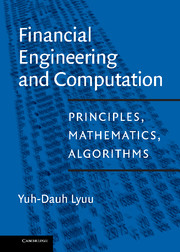Book contents
- Frontmatter
- Contents
- Preface
- Useful Abbreviations
- 1 Introduction
- 2 Analysis of Algorithms
- 3 Basic Financial Mathematics
- 4 Bond Price Volatility
- 5 Term Structure of Interest Rates
- 6 Fundamental Statistical Concepts
- 7 Option Basics
- 8 Arbitrage in Option Pricing
- 9 Option Pricing Models
- 10 Sensitivity Analysis of Options
- 11 Extensions of Options Theory
- 12 Forwards, Futures, Futures Options, Swaps
- 13 Stochastic Processes and Brownian Motion
- 14 Continuous-Time Financial Mathematics
- 15 Continuous-Time Derivatives Pricing
- 16 Hedging
- 17 Trees
- 18 Numerical Methods
- 19 Matrix Computation
- 20 Time Series Analysis
- 21 Interest Rate Derivative Securities
- 22 Term Structure Fitting
- 23 Introduction to Term Structure Modeling
- 24 Foundations of Term Structure Modeling
- 25 Equilibrium Term Structure Models
- 26 No-Arbitrage Term Structure Models
- 27 Fixed-Income Securities
- 28 Introduction to Mortgage-Backed Securities
- 29 Analysis of Mortgage-Backed Securities
- 30 Collateralized Mortgage Obligations
- 31 Modern Portfolio Theory
- 32 Software
- 33 Answers to Selected Exercises
- Bibliography
- Glossary of Useful Notations
- Index
5 - Term Structure of Interest Rates
Published online by Cambridge University Press: 19 September 2009
- Frontmatter
- Contents
- Preface
- Useful Abbreviations
- 1 Introduction
- 2 Analysis of Algorithms
- 3 Basic Financial Mathematics
- 4 Bond Price Volatility
- 5 Term Structure of Interest Rates
- 6 Fundamental Statistical Concepts
- 7 Option Basics
- 8 Arbitrage in Option Pricing
- 9 Option Pricing Models
- 10 Sensitivity Analysis of Options
- 11 Extensions of Options Theory
- 12 Forwards, Futures, Futures Options, Swaps
- 13 Stochastic Processes and Brownian Motion
- 14 Continuous-Time Financial Mathematics
- 15 Continuous-Time Derivatives Pricing
- 16 Hedging
- 17 Trees
- 18 Numerical Methods
- 19 Matrix Computation
- 20 Time Series Analysis
- 21 Interest Rate Derivative Securities
- 22 Term Structure Fitting
- 23 Introduction to Term Structure Modeling
- 24 Foundations of Term Structure Modeling
- 25 Equilibrium Term Structure Models
- 26 No-Arbitrage Term Structure Models
- 27 Fixed-Income Securities
- 28 Introduction to Mortgage-Backed Securities
- 29 Analysis of Mortgage-Backed Securities
- 30 Collateralized Mortgage Obligations
- 31 Modern Portfolio Theory
- 32 Software
- 33 Answers to Selected Exercises
- Bibliography
- Glossary of Useful Notations
- Index
Summary
He pays least […] who pays latest.
Charles de Montesquieu (1689–1755), The Spirit of LawsThe term structure of interest rates is concerned with how the interest rates change with maturity and how they may evolve in time. It is fundamental to the valuation of fixed-income securities. This subject is important also because the term structure is the starting point of any stochastic theory of interest rate movements. Interest rates in this chapter are period based unless stated otherwise. This simplifies the presentation by eliminating references to the compounding frequency per annum.
Introduction
The set of yields to maturity for bonds of equal quality and differing solely in their terms to maturity forms the term structure. This term often refers exclusively to the yields of zero-coupon bonds. Term to maturity is the time period during which the issuer has promised to meet the conditions of the obligation. A yield curve plots yields to maturity against maturity and represents the prevailing interest rates for various terms. See Fig. 5.1 for a sample Treasury yield curve. A par yield curve is constructed from bonds trading near their par value.
At least four yield-curve shapes can be identified. A normal yield curve is upward sloping, an inverted yield curve is downward sloping, a flat yield curve is flat (see Fig. 5.2), and a humped yield curve is upward sloping at first but then turns downward sloping. We will survey the theories advanced to explain the shapes of the yield curve in Section 5.1.
The U.S. Treasury yield curve is the most widely followed yield curve for the following reasons.
- Type
- Chapter
- Information
- Financial Engineering and ComputationPrinciples, Mathematics, Algorithms, pp. 45 - 63Publisher: Cambridge University PressPrint publication year: 2001



